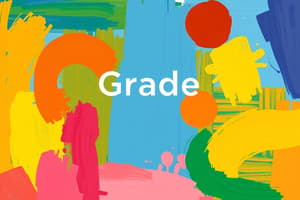Podcast
Questions and Answers
What does identifying the main idea of a passage involve?
What does identifying the main idea of a passage involve?
- Summarizing the text in one sentence.
- Recognizing the central point or theme of the text. (correct)
- Finding all the details mentioned in the text.
- Visualizing characters and settings.
Which of the following is NOT considered a type of text?
Which of the following is NOT considered a type of text?
- Illustrations (correct)
- Poetry
- Non-Fiction
- Fiction
What skill involves drawing conclusions based on hints in the text?
What skill involves drawing conclusions based on hints in the text?
- Character Analysis
- Inference (correct)
- Setting Identification
- Summarization
Which strategy would be most helpful before reading to enhance understanding?
Which strategy would be most helpful before reading to enhance understanding?
Which technique involves students recounting the story in their own words?
Which technique involves students recounting the story in their own words?
What is the purpose of character analysis in reading comprehension?
What is the purpose of character analysis in reading comprehension?
Which of the following enhances listening skills and comprehension?
Which of the following enhances listening skills and comprehension?
What is a graphic organizer used for in reading comprehension?
What is a graphic organizer used for in reading comprehension?
Flashcards are hidden until you start studying
Study Notes
Reading Comprehension for Grade 3
-
Definition: Understanding and interpreting the meaning of texts.
-
Key Skills:
- Identifying Main Ideas: Recognizing the central point or theme of a passage.
- Supporting Details: Finding facts or examples that back up the main idea.
- Inference: Drawing conclusions based on hints or clues in the text, not just what is explicitly stated.
- Summarization: Condensing the text into a shorter form, highlighting key points.
- Character Analysis: Understanding characters' traits, motivations, and changes throughout the story.
- Setting Identification: Recognizing the time and place in which the story occurs.
-
Types of Texts:
- Fiction: Stories that are not real; includes plots, characters, and settings.
- Non-Fiction: Informational texts that provide factual information.
- Poetry: Written in verse, may have rhythm and often uses figurative language.
-
Strategies for Improvement:
- Previewing Text: Looking at titles, headings, and images before reading.
- Questioning: Asking questions during and after reading to enhance understanding.
- Visualizing: Creating mental images based on the text.
- Rereading: Reading difficult passages again for better understanding.
- Discussion: Talking about the text with peers to explore ideas and interpretations.
-
Assessment Techniques:
- Multiple Choice Questions: Assess understanding of key ideas and details.
- Short Answer Questions: Require explanations or descriptions based on the text.
- Retellings: Asking students to recount the story in their own words.
- Graphic Organizers: Using charts to organize information from the text visually.
-
Encouraging Engagement:
- Reading Aloud: Enhances listening skills and comprehension.
- Book Clubs: Promotes discussion and various perspectives on texts.
- Interactive Activities: Engaging games or projects related to the reading material.
Reading Comprehension for Grade 3
- Understanding reading comprehension involves interpreting and grasping the meanings of various texts.
- Key skills include identifying main ideas, supporting details, making inferences, summarizing content, analyzing characters, and recognizing settings.
Key Skills Explained
- Identifying Main Ideas: Focus on the central theme or key point of a passage.
- Supporting Details: Locate facts and examples that clarify or strengthen the main idea.
- Inference: Draw conclusions from hints or clues in the text rather than relying solely on explicit statements.
- Summarization: Condense longer passages into shorter versions, emphasizing essential points.
- Character Analysis: Explore characters’ traits, motivations, and their development throughout the narrative.
- Setting Identification: Identify the time and location in which the story unfolds.
Types of Texts
- Fiction: Consists of imaginative stories with crafted plots, characters, and settings.
- Non-Fiction: Contains factual information aimed at educating or informing readers.
- Poetry: Structured verse that often employs rhythm and figurative language to convey emotions or ideas.
Strategies for Improvement
- Previewing Text: Examine titles, headings, and illustrations prior to reading for context.
- Questioning: Pose questions during and after the reading to deepen comprehension.
- Visualizing: Create mental images to better understand and engage with the text.
- Rereading: Revisit challenging sections to clarify understanding.
- Discussion: Engage in conversations with peers to unpack ideas and interpretations of the text.
Assessment Techniques
- Multiple Choice Questions: Evaluate grasp of key concepts and details.
- Short Answer Questions: Require students to explain or describe elements from the text.
- Retellings: Encourage recounting of stories in students' own words to assess comprehension.
- Graphic Organizers: Utilize charts to visually represent and organize information extracted from the text.
Encouraging Engagement
- Reading Aloud: Boosts listening skills and understanding of the material.
- Book Clubs: Facilitate discussions that provide diverse perspectives on texts.
- Interactive Activities: Incorporate games or projects related to the reading material to enhance involvement and learning.
Studying That Suits You
Use AI to generate personalized quizzes and flashcards to suit your learning preferences.




